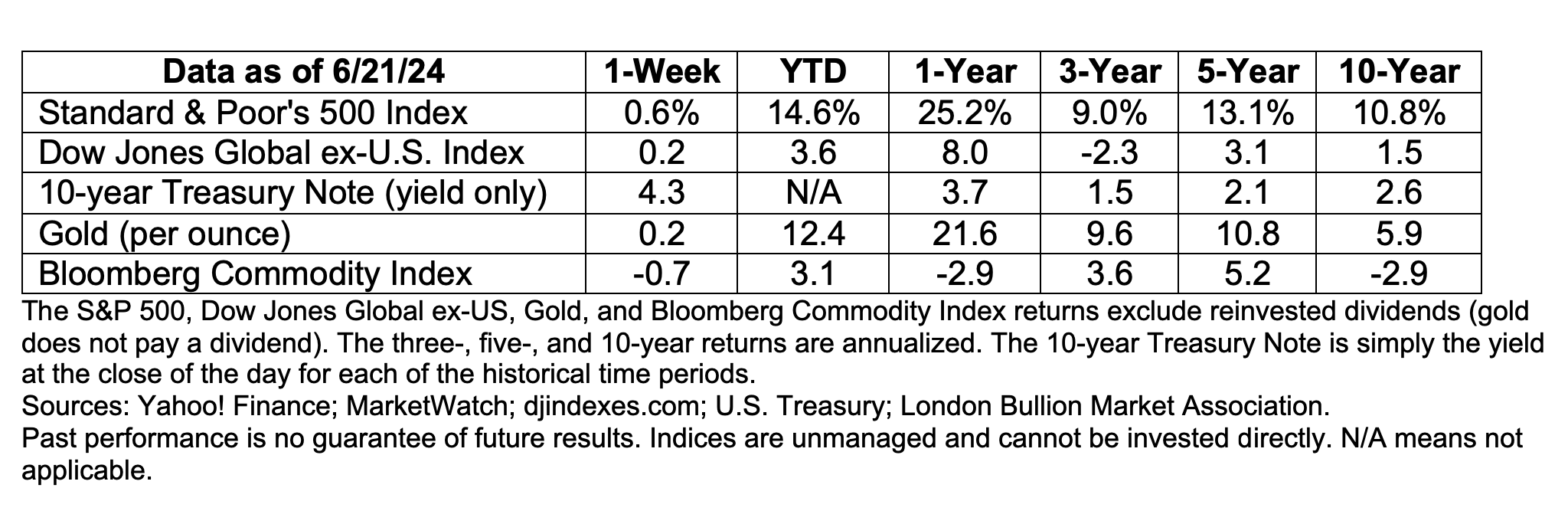June 24, 2024
The Markets
Are we at an inflection point?
The transition to renewable energy has been moving forward and may be reaching an inflection point. In 2023, global renewable energy capacity increased by almost 50 percent, reported the International Energy Agency (IEA). Renewable capacity reached all-time highs in the United States, Europe, and Brazil. However, the leader in new capacity is China. In 2023, the country “commissioned as much solar PV [photovoltaic] as the entire world did in 2022,” stated the IEA’s Renewables 2023 report.
In the United States, solar power is responsible for a relatively small amount (3.9 percent in 2023) of all electricity generated; however, solar is growing faster than any other source of electricity. One reason for the growth is Big Tech companies’ commitment to clean energy. Four of the “Magnificent Seven” were responsible for “40% of the demand for large, utility-scale solar projects in the U.S. over the past five years,” reported Spencer Kimball and Gabriel Cortés of CNBC.
“To call solar power’s rise exponential is not hyperbole, but a statement of fact. Installed solar capacity doubles roughly every three years, and so grows ten-fold each decade. Such sustained growth is seldom seen in anything that matters. That makes it hard for people to get their heads round what is going on. When it was a tenth of its current size ten years ago, solar power was still seen as marginal even by experts who knew how fast it had grown. The next ten-fold increase will be equivalent to multiplying the world’s entire fleet of nuclear reactors by eight in less than the time it typically takes to build just a single one of them,” reported The Economist.
The IEA forecasted that by 2028 renewable energy sources will generate more than 42 percent of the world’s electricity. Wind and solar PV energy sources are expected to deliver about 25 percent of global electricity.
There are some obstacles to renewable energy growth, though. Current constraints include siting, permitting and grids, reported BloombergNEF. From 2000 to 2018, just 20 percent of U.S. renewable energy projects that sought to be connected to the power grid were actually connected.
“Grids were not originally set up for such a fast-paced energy system; their tools and processes were developed in a slower, less volatile world…[Renewable energy source] infrastructures are already available and rapidly increasing. However, taking advantage of renewables requires a power grid that can accommodate these intermittent energy sources,” reported McKinsey & Company’s Adam Barth and colleagues.
Last week, major stock market indices finished higher with the Standard & Poor’s 500 Index chalking up its 31st record high for 2024 during the week, reported Jacob Sonenshine of Barron’s. Many maturities of U.S. Treasury bonds finished this week slightly higher than they ended last week.

Weekly Focus – Think About It
“Don’t tell me where your priorities are. Show me where you spend your money, and I’ll tell you what they are.”
― James W. Frick, former development officer, University of Notre Dame
Required Disclosures:
* These views are those of Carson Coaching, not the presenting Representative, the Representative’s Broker/Dealer, or Registered Investment Advisor, and should not be construed as investment advice.
* This newsletter was prepared by Carson Coaching. Carson Coaching is not affiliated with the named firm or broker/dealer.
* Government bonds and Treasury Bills are guaranteed by the U.S. government as to the timely payment of principal and interest and, if held to maturity, offer a fixed rate of return and fixed principal value. However, the value of fund shares is not guaranteed and will fluctuate.
* Corporate bonds are considered higher risk than government bonds but normally offer a higher yield and are subject to market, interest rate and credit risk as well as additional risks based on the quality of issuer coupon rate, price, yield, maturity, and redemption features.
* The Standard & Poor’s 500 (S&P 500) is an unmanaged group of securities considered to be representative of the stock market in general. You cannot invest directly in this index.
* All indexes referenced are unmanaged. The volatility of indexes could be materially different from that of a client’s portfolio. Unmanaged index returns do not reflect fees, expenses, or sales charges. Index performance is not indicative of the performance of any investment. You cannot invest directly in an index.
* The Dow Jones Global ex-U.S. Index covers approximately 95% of the market capitalization of the 45 developed and emerging countries included in the Index.
* The 10-year Treasury Note represents debt owed by the United States Treasury to the public. Since the U.S. Government is seen as a risk-free borrower, investors use the 10-year Treasury Note as a benchmark for the long-term bond market.
* Gold represents the 3:00 p.m. (London time) gold price as reported by the London Bullion Market Association and is expressed in U.S. Dollars per fine troy ounce. The source for gold data is Federal Reserve Bank of St. Louis (FRED), https://fred.stlouisfed.org/series/GOLDPMGBD228NLBM.
* The Bloomberg Commodity Index is designed to be a highly liquid and diversified benchmark for the commodity futures market. The Index is composed of futures contracts on 19 physical commodities and was launched on July 14, 1998.
* The DJ Equity All REIT Total Return Index measures the total return performance of the equity subcategory of the Real Estate Investment Trust (REIT) industry as calculated by Dow Jones.
* The Dow Jones Industrial Average (DJIA), commonly known as “The Dow,” is an index representing 30 stock of companies maintained and reviewed by the editors of The Wall Street Journal.
* The NASDAQ Composite is an unmanaged index of securities traded on the NASDAQ system.
* International investing involves special risks such as currency fluctuation and political instability and may not be suitable for all investors. These risks are often heightened for investments in emerging markets.
* Yahoo! Finance is the source for any reference to the performance of an index between two specific periods.
* The risk of loss in trading commodities and futures can be substantial. You should therefore carefully consider whether such trading is suitable for you in light of your financial condition. The high degree of leverage is often obtainable in commodity trading and can work against you as well as for you. The use of leverage can lead to large losses as well as gains.
* Opinions expressed are subject to change without notice and are not intended as investment advice or to predict future performance.
* Economic forecasts set forth may not develop as predicted and there can be no guarantee that strategies promoted will be successful.
* Past performance does not guarantee future results. Investing involves risk, including loss of principal.
* The foregoing information has been obtained from sources considered to be reliable, but we do not guarantee it is accurate or complete.
* There is no guarantee a diversified portfolio will enhance overall returns or outperform a non-diversified portfolio. Diversification does not protect against market risk.
* Asset allocation does not ensure a profit or protect against a loss.
* Consult your financial professional before making any investment decision.
* To unsubscribe from the “Enter the name of your commentary” please click here or write us at “Your Address Here”.
* To unsubscribe from the “Enter the name of your commentary” please reply to this email with “Unsubscribe” in the subject line or write us at “Your Address Here”.
Sources:
https://www.iea.org/reports/renewables-2023/executive-summary
https://www.economist.com/leaders/2024/06/20/the-exponential-growth-of-solar-power-will-change-the-world (or go to https://resources.carsongroup.com/hubfs/WMC-Source/2024/06-24-24_Economist_The%20Exponential%20Growth%20of%20Solar%20Power%20Will%20Change%20the%20World_2.pdf)
https://www.cnbc.com/2024/06/19/solar-is-growing-faster-than-any-energy-source-as-clean-power-for-data-centers.html
https://about.bnef.com/blog/us-clean-power-at-inflection-point-bnef-summit-new-york/ (or go to https://resources.carsongroup.com/hubfs/WMC-Source/2024/06-24-24_BloombergNEF_US%20Clean%20Power%20at%20Inflection%20Point_4.pdf)
https://www.mckinsey.com/industries/electric-power-and-natural-gas/our-insights/how-grid-operators-can-integrate-the-coming-wave-of-renewable-energy
https://www.barrons.com/articles/stock-market-rally-ending-5ed9e442?refsec=the-trader&mod=topics_the-trader (or go to https://resources.carsongroup.com/hubfs/WMC-Source/2024/06-24-24_Barrons_Its%20Been%20a%20Good%20Bull%20Run%20for%20Stocks_6.pdf)
https://home.treasury.gov/resource-center/data-chart-center/interest-rates/TextView?type=daily_treasury_yield_curve&field_tdr_date_value_month=202406
https://www.msn.com/en-us/money/markets/americans-throw-away-up-to-68-million-in-coins-a-year-here-is-where-it-all-ends-up/ar-BB1lMi8d
https://www.usmint.gov/wordpress/wp-content/uploads/2023/04/2022-USM-Biennial-Report_P5_FINAL.pdf [Pages 4, 6, 8-9]
https://www.goodreads.com/author/quotes/21470345.James_W_Frick








